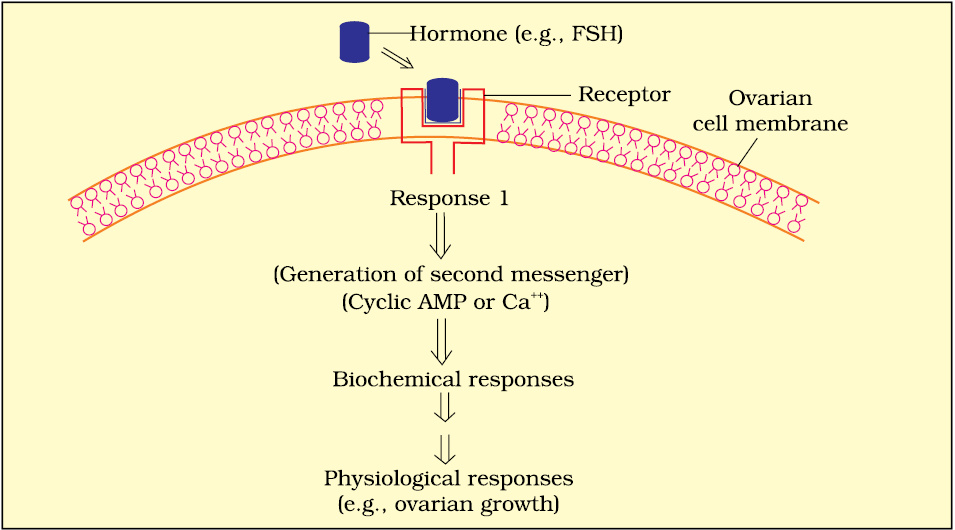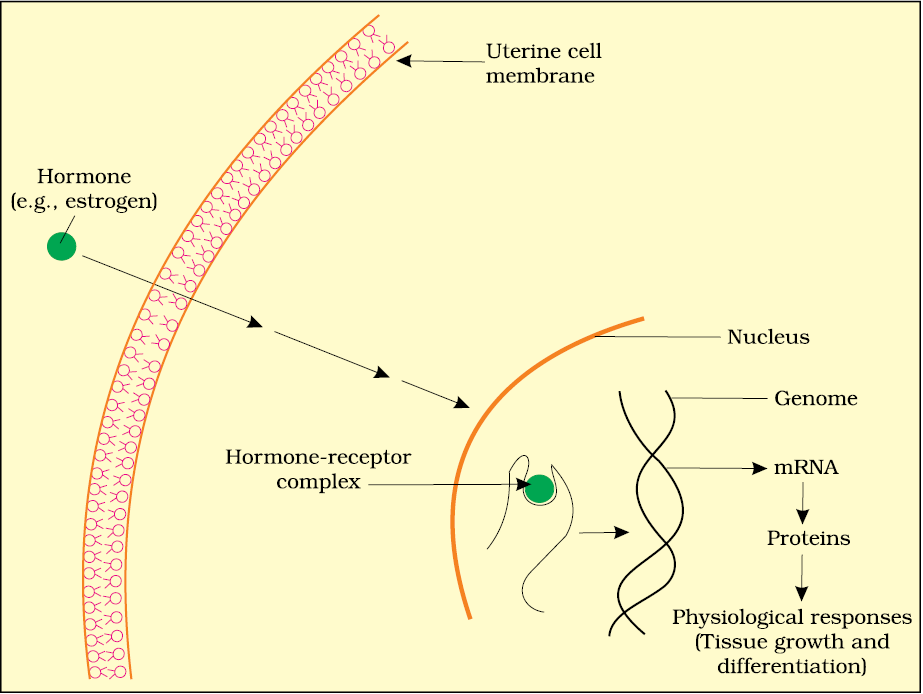Hormones produce their effects on target tissues by binding to specific proteins called hormone receptors located in the target tissues only. Hormone receptors present on the cell membrane of the target cells are called membrane-bound receptors and the receptors present inside the target cell are called intracellular receptors, mostly nuclear receptors (present in the nucleus). Binding of a hormone to its receptor leads to the formation of a hormone-receptor complex (Figure 22.5 a, b). Each receptor is specific to one hormone only and hence receptors are specific. Hormone-Receptor complex formation leads to certain biochemical changes in the target tissue. Target tissue metabolism and hence physiological functions are regulated by hormones. On the basis of their chemical nature, hormones can be divided into groups :
(i) peptide, polypeptide, protein hormones (e.g., insulin, glucagon, pituitary hormones, hypothalamic hormones, etc.)
(ii) steroids (e.g., cortisol, testosterone, estradiol and progesterone)
(iii) iodothyronines (thyroid hormones)
(iv) amino-acid derivatives (e.g., epinephrine).
Hormones which interact with membrane-bound receptors normally do not enter the target cell, but generate second messengers (e.g., cyclic AMP, IP3, Ca++ etc) which in turn regulate cellular metabolism (Figure 22.5a). Hormones which interact with intracellular receptors (e.g., steroid hormones, iodothyronines, etc.) mostly regulate gene expression or chromosome function by the interaction of hormone-receptor complex with the genome. Cumulative biochemical actions result in physiological and developmental effects (Figure 22.5b).

(a)

Figure 22.5 Diagramatic representation of the mechanism of hormone action :
(a) Protein hormone
(b) Steroid hormone
There are special chemicals which act as hormones and provide chemical coordination, integration and regulation in the human body. These hormones regulate metabolism, growth and development of our organs, the endocrine glands or certain cells. The endocrine system is composed of hypothalamus, pituitary and pineal, thyroid, adrenal, pancreas, parathyroid, thymus and gonads (testis and ovary). In addition to these, some other organs, e.g., gastrointestinal tract, kidney, heart etc., also produce hormones. The pituitary gland is divided into three major parts, which are called as pars distalis, pars intermedia and pars nervosa. Pars distalis produces six trophic hormones. Pars intermedia secretes only one hormone, while pars nervosa (neurohypophysis) secretes two hormones. The pituitary hormones regulate the growth and development of somatic tissues and activities of peripheral endocrine glands. Pineal gland secretes melatonin, which plays a very important role in the regulation of 24-hour (diurnal) rhythms of our body (e.g., rhythms of sleep and state of being awake, body temperature, etc.). The thyroid gland hormones play an important role in the regulation of the basal metabolic rate, development and maturation of the central neural system, erythropoiesis, metabolism of carbohydrates, proteins and fats, menstrual cycle. Another thyroid hormone, i.e., thyrocalcitonin regulates calcium levels in our blood by decreasing it. The parathyroid glands secrete parathyroid hormone (PTH) which increases the blood Ca2+ levels and plays a major role in calcium homeostasis. The thymus gland secretes thymosins which play a major role in the differentiation of T-lymphocytes, which provide cell-mediated immunity. In addition, thymosins also increase the production of antibodies to provide humoral immunity. The adrenal gland is composed of the centrally located adrenal medulla and the outer adrenal cortex. The adrenal medulla secretes epinephrine and norepinephrine. These hormones increase alertness, pupilary dilation, piloerection, sweating, heart beat, strength of heart contraction, rate of respiration, glycogenolysis, lipolysis, proteolysis. The adrenal cortex secretes glucocorticoids and mineralocorticoids. Glucocorticoids stimulate gluconeogenesis, lipolysis, proteolysis, erythropoiesis, cardio-vascular system, blood pressure, and glomerular filtration rate and inhibit inflammatory reactions by suppressing the immune response. Mineralocorticoids regulate water and electrolyte contents of the body. The endocrine pancreas secretes glucagon and insulin. Glucagon stimulates glycogenolysis and gluconeogenesis resulting in hyperglycemia. Insulin stimulates cellular glucose uptake and utilisation, and glycogenesis resulting in hypoglycemia. Insulin deficiency and/or insulin resistance result in a disease called diabetes mellitus.
1. Define the following:
(a) Exocrine gland
(b) Endocrine gland
(c) Hormone
NEETprep Answer2. Diagrammatically indicate the location of the various endocrine glands in our body.
NEETprep Answer3. List the hormones secreted by the following:
(a) Hypothalamus (b) Pituitary (c) Thyroid (d) Parathyroid
(e) Adrenal (f) Pancreas (g) Testis (h) Ovary
(i) Thymus (j) Atrium (k) Kidney (l) G-I Tract
NEETprep Answer4. Fill in the blanks:
Hormones Target gland
(a) Hypothalamic hormones __________________
(b) Thyrotrophin (TSH) __________________
(c) Corticotrophin (ACTH) __________________
(d) Gonadotrophins (LH, FSH) __________________
(e) Melanotrophin (MSH) __________________
NEETprep Answer5. Write short notes on the functions of the following hormones:
(a) Parathyroid hormone (PTH) (b) Thyroid hormones
(c) Thymosins (d) Androgens
(e) Estrogens (f) Insulin and Glucagon
NEETprep Answer6. Give example(s) of:
(a) Hyperglycemic hormone and hypoglycemic hormone
(b) Hypercalcemic hormone
(c) Gonadotrophic hormones
(d) Progestational hormone
(e) Blood pressure lowering hormone
(f) Androgens and estrogens
NEETprep Answer7. Which hormonal deficiency is responsible for the following:
(a) Diabetes mellitus (b) Goitre (c) Cretinism
NEETprep Answer8. Briefly mention the mechanism of action of FSH.
NEETprep Answer9. Match the following:
| Column I | Column II |
|---|---|
| (a) T4 | (i) Hypothalamus |
| (b) PTH | (ii) Thyroid |
| (c) GnRH | (iii) Pituitary |
| (d) LH | (iv) Parathyroid |